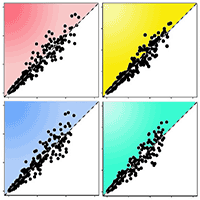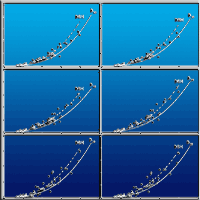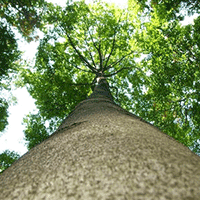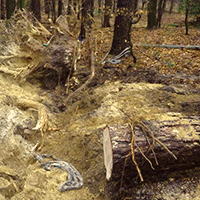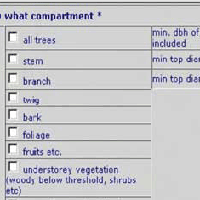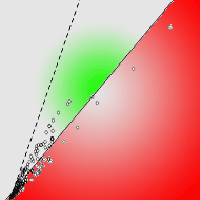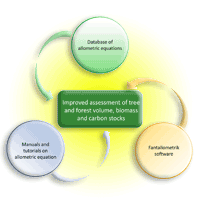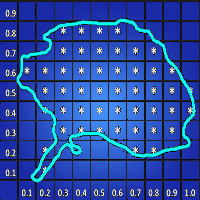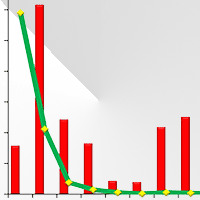
Effects of planting density on the distribution of biomass in a douglas-fir plantation in southern Italy
Pasquale A Marziliano (1) , Vittoria Coletta (2), Giuliano Menguzzato (1), Antonino Nicolaci (3), Gaetano Pellicone (2), Antonella Veltri (2)
iForest - Biogeosciences and Forestry, Volume 8, Issue 3, Pages 368-376 (2015)
doi: https://doi.org/10.3832/ifor1078-007
Published: Sep 09, 2014 - Copyright © 2015 SISEF
Research Articles
Abstract
The effects of initial planting densities on the distribution of above-ground biomass of Douglas-fir (Pseudotsuga menziesii [Mirb.] Franco var. menziesii) were investigated in a plantation in southern Italy. Allometric equations designed for the plantation under study were used to estimate above-ground biomass and in particular partitioning to stem and crown compartments. A comparison between biomass estimated with allometric equations and biomass estimated with a constant biomass expansion factor (BEF) from the Italian National Forest Inventory (INFC 2005) was carried out. Moreover, a BEF calculated as the ratio of total above-ground or compartment biomass to stem volume was used to define the sensitivity of BEF to age and to tree density. Variation of above-ground standing biomass estimated with allometric equations was evaluated according to 6 differing planting densities (833, 1000, 1250, 1667, 2000 and 2500 trees per hectare). In the first 20 years after planting higher biomass stock was detected in high density plots, but after the age of 32 years differences between plots disappeared. When the plantation was 40 years old, a higher amount of total biomass was observed in plots of 2000 trees per hectare (about 405 Mg ha-1), a lower amount in plots of 2500 trees per hectare (about 381 Mg ha-1). The Douglas-fir plantation has a total above-ground carbon stock of 197 Mg C ha-1 at the age of 40 and a mean annual CO2 sequestration of 18 Mg ha-1 y-1. Constant BEF from INFC underestimated biomass on average by 11% for ages 15 and 25 and overestimated biomass on average by 16% for older ages. BEFs expressed as a ratio of biomass to stem volume significantly depended upon age and planting density, with decreasing trends for total, stem and crown compartments. Our results indicated that total above-ground biomass production is not influenced by different tree density if considered over a long period. If cutting cycles are short, planting density on average of 2000 trees per hectare may ensure high biomass production rates; if cutting cycles are longer, 1000-1200 trees per hectare could also be a valid choice.
Keywords
Allometric Equations, Biomass, Biomass Expansion Factor, Carbon, Douglas-fir, Planting Density, Spacing Trial
Authors’ Info
Authors’ address
Giuliano Menguzzato
Department of Agraria, Mediterranean University of Reggio Calabria, loc. Feo di Vito, I-89060 Reggio Calabria (Italy)
Gaetano Pellicone
Antonella Veltri
ISAFoM, Institute for Mediterranean Agriculture and Forest Systems, CNR - National Research Council, I-87037 Rende (CS, Italy)
Department of Chemical and Environmental Engineering, University of Calabria, Campus di Arcavacata, I-87037 Rende (CS, Italy)
Corresponding author
Paper Info
Citation
Marziliano PA, Coletta V, Menguzzato G, Nicolaci A, Pellicone G, Veltri A (2015). Effects of planting density on the distribution of biomass in a douglas-fir plantation in southern Italy. iForest 8: 368-376. - doi: 10.3832/ifor1078-007
Academic Editor
Emanuele Lingua
Paper history
Received: Jul 18, 2013
Accepted: Jun 05, 2014
First online: Sep 09, 2014
Publication Date: Jun 01, 2015
Publication Time: 3.20 months
Copyright Information
© SISEF - The Italian Society of Silviculture and Forest Ecology 2015
Open Access
This article is distributed under the terms of the Creative Commons Attribution-Non Commercial 4.0 International (https://creativecommons.org/licenses/by-nc/4.0/), which permits unrestricted use, distribution, and reproduction in any medium, provided you give appropriate credit to the original author(s) and the source, provide a link to the Creative Commons license, and indicate if changes were made.
Web Metrics
Breakdown by View Type
Article Usage
Total Article Views: 55926
(from publication date up to now)
Breakdown by View Type
HTML Page Views: 46709
Abstract Page Views: 3481
PDF Downloads: 4306
Citation/Reference Downloads: 27
XML Downloads: 1403
Web Metrics
Days since publication: 4130
Overall contacts: 55926
Avg. contacts per week: 94.79
Citation Metrics
Article Citations
Article citations are based on data periodically collected from the Clarivate Web of Science web site
(last update: Mar 2025)
Total number of cites (since 2015): 23
Average cites per year: 2.09
Publication Metrics
by Dimensions ©
Articles citing this article
List of the papers citing this article based on CrossRef Cited-by.
References
The principles of forest yield study. Studies in the organic production, structure, increment and yield of forest stands. Pergamon Press, Oxford, UK, pp. 506.
Gscholar
Effetti dei diradamenti sull’umidità del suolo in popolamenti di douglasia della Catena Costiera (Calabria) [Effects of thinning on soil water content in Douglas-fir stands in the Coastal Chain (Calabria)]. Annali dell’Istituto Sperimentale per la Selvicoltura 20: 13-39. [in Italian]
Gscholar
Sul clima e sulla distribuzione altimetrica della vegetazione forestale in Calabria [Climate and altimetric distribution of forest vegetation in Calabria]. Annali dell’Istituto Sperimentale per la Selvicoltura Arezzo 2: 321-370. [in Italian]
Gscholar
Le specie forestali esotiche nella selvicoltura italiana [Exotic forest species in the Italian silviculture]. Annali dell’Istituto Sperimentale per la Selvicoltura Arezzo 12/13: 731. [in Italian]
Gscholar
Effetti della densità di impianto sulla produzione in piantagioni di douglasia [Effects of planting density on productivity of Douglas fir plantations]. In: Proceedings of the IV SISEF Congress “Meridiani Foreste” (Caivano F, Girardi T, Pierangeli D, Borghetti M eds). Rifreddo (PZ, Italy) 7-10 Oct 2003. SISEF, Potenza, Italy, pp. 87-93. [in Italian]
Gscholar
Five year vegetation control effects on aboveground biomass and nitrogen content and allocation in Douglas-fir plantations on three contrasting sites. Forest Ecology and Management 262: 2187-2198.
CrossRef | Gscholar
Slash pine: still growing and growing! Gen. Tech. Rep. SRS-76, USDA Forest Service, Southern Research Station, Asheville, NC, USA, pp. 148.
Gscholar
Stand density effects on biomass allocation patterns and subsequent soil nitrogen demand. In: Proceedings of the “9th Biennial Southern Silvicultural Research Conference” (Waldrop TA ed). Clemson (SC, USA) 25-27 Feb 1997. Gen. Tech. Report SRS-20, Southern Research Station, USDA Forest Service, Ashevill, NC, USA, pp. 564-568.
Gscholar
World reference base for soil resources. The latest WRB classification manual. Food and Agriculture Organization of the United Nations, Rome, Italy, pp. 128.
Gscholar
Branching. crown structure and control of timber production. In: “Attributes of trees as crop plants” (Cannell MGR, Jackson JE eds). Institute of Terrestrial Ecology, Abbots Ripton, UK, pp. 228-252.
Gscholar
Revised 1996 guidelines for national greenhouse gas inventories. IPCC/OECD/IEA, Paris, France.
Gscholar
Linee generali del progetto per il secondo inventario forestale nazionale italiano [General guidelines of the project for the second national italian forest inventory]. In: “Inventario Nazionale delle Foreste e dei serbatoi forestali di Carbonio” (De Natale F, Floris A, Gasparini P, Scrinzi G, Tabacchi G, Tosi V eds). MiPAF - Ispettorato Generale del Corpo Forestale dello Stato, ISAFA, Trento, Italy, pp. 57. [in Italian]
Gscholar
Slash pine plantation study - age 30. In: Proceedings of the “4th Biennial Southern Silviculture Conference” (Phyllips JR ed). Atlanta (GA, USA) 4-6 Nov 1986. Gen. Tech. Rep. SE-42, Southeastern Forest Experiment Station, USDA Forest Service, Asheville, NC, USA, pp. 45-49.
Gscholar
Auswirkungen von Douglasien-Pflanzverbanden auf Aststarken und Vernutzung sowie Uberlegungen zur Astungshohe [Impacts of planting density in a Douglas-fir plantation on the branches basal diameter and insertion height]. Allg Forst und Jagdzeitung 152 (8/9): 168-180. [in German]
Gscholar
Preliminary results on spacing of trees in some Douglas-fir plantations in Italy. In: Proceedings of the IUFRO Project Group P4.02.02 Meeting “The influence of spacing and selectivity in thinning on stand development. Operations and economy” (Gallagher G ed). Dublin (Ireland) 24-28 Sep 1984. IUFRO, Vienna, Austria, pp 169.
Gscholar
Carbon dioxide reductions through urban forestry: guidelines for professional and volunteer tree planters. Report no. PSW GTR-171, Pacific Southwest Research Station, USDA Forest Service, Albany, CA, USA, pp. 237.
Gscholar
Prove sperimentali sulle distanze d’impianto in piantagioni di douglasia sulla Catena Costiera (Calabria) [Experimental trials on planting densities in Douglas fir plantations on the Coastal Chain (Calabria)]. L’Italia Forestale e Montana 50 (2): 170-189. [in Italian]
Gscholar
Modelling the growth of Douglas-fir in France. Mitteilungen der Forstlichen Bundesversuchsanstalt Wien 147:25-39.
Gscholar
The effect of thinning, age, and site on foliage, increment, and loss of dry matter. Journal of Forestry 45: 393-404.
Gscholar
Introduction to statistical quality control (4th edn). John Wiley & Sons, New York, USA, pp. 795.
Gscholar
Forest stand dynamics (update edn). John Wiley and Sons, New York, USA, pp. 467
Gscholar
Le classificazioni fitoclimatiche ed i caratteri della stazione [Phytoclimatic classifications and station characteristics]. Scritti di ecologia selvicoltura e botanica forestale, pp. 45-116. [in Italian]
Gscholar
Carbon inventory methods. Handbook for greenhouse gas inventory, carbon mitigation and roundwood production projects. Advances in Global Change Research 29, Springer, Heidelberg, Germany, pp. 304.
Gscholar
Fifty-year development of Douglas-fir stands planted at various spacings. Research Paper PNW-253, Pacific Northwest Forest and Range Experiment Station, USDA Forest Service, Portland, OR, USA, pp. 21.
Gscholar
Forest biomass. Martinus Nijhoff/Junk, The Hague, London, pp. 152.
Gscholar
Terminology in assessing and reporting forest carbon change. In: “Second expert meeting on harmonizing forest-related definitions for use by various stakeholders”. FAO, Rome, Italy, pp. 8.
Gscholar
Kyoto protocol to the United Nations framework convention on climate change. United Nations Environmental Program, Kyoto, Japan, pp. 20.
Gscholar
Forest ecosystems: concepts and management. Academic Press, Orlando, FL, USA, pp. 340.
Gscholar
Biostatistical analysis (3rd edn). Prentice Hall Inc., Englewood Cliffs, NJ, USA, pp. 718.
Gscholar


